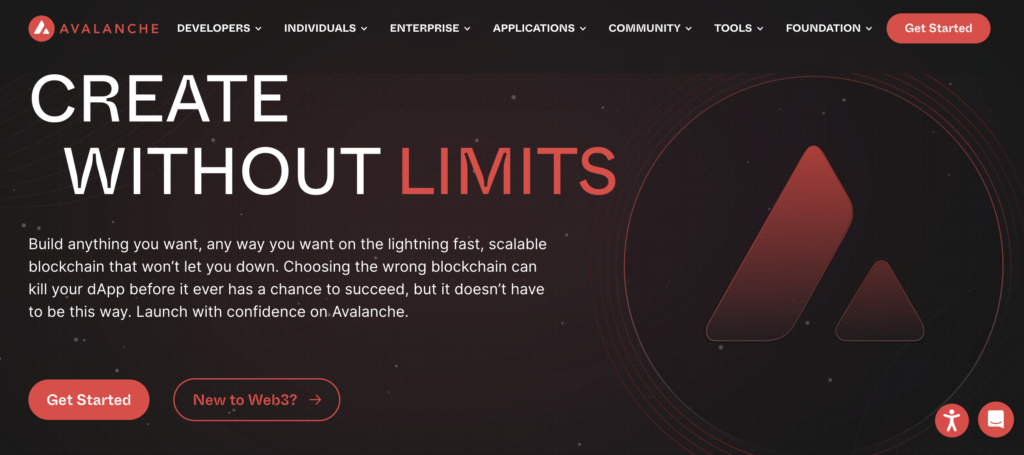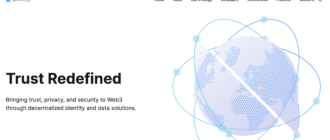Avalanche stands out in the crowded field of blockchain technology with its unique approach to scalability, decentralization, and security. It aims to address the blockchain trilemma by providing a platform that does not sacrifice any of the three key pillars: security, scalability, and decentralization.

History of the Project
Avalanche was developed by Ava Labs, a company founded by Emin Gün Sirer, Kevin Sekniqi, and Ted Yin, all of whom have strong backgrounds in computer science and specifically, decentralized systems. The project was publicly announced in 2020 and quickly gained attention due to its novel consensus mechanism and its ability to facilitate high transaction throughput. The mainnet launch later in the same year marked a significant milestone, positioning Avalanche as a serious contender in the blockchain space.
What is Avalanche?
Avalanche is a blockchain platform designed to host custom blockchain networks, which it calls “subnets,” while providing a robust infrastructure for decentralized applications (dApps) and custom blockchain deployments. Its primary objective is to resolve throughput and latency issues found in earlier blockchain generations, enabling near-instant transaction finality.
How the Avalanche Project Works?
Avalanche’s technology stack is distinguished by several key innovations that set it apart from traditional blockchain systems. Here, we delve into the specific technologies and the roles they play:
Avalanche Consensus Mechanism
Unlike traditional blockchain consensus mechanisms, such as Proof of Work (PoW) or Proof of Stake (PoS), Avalanche utilizes a unique consensus protocol known as the Avalanche Consensus. This protocol is categorized under a broader family of consensus mechanisms called “DAG-based protocols” (Directed Acyclic Graph), but with a distinctive approach that combines the benefits of classical consensus and Nakamoto consensus.
- Speed and Scalability: The Avalanche Consensus can achieve consensus on a transaction in milliseconds to seconds, supporting up to 4,500 transactions per second on a single subnet.
- Robustness: It provides a high degree of security equivalent to that of Bitcoin’s PoW, yet it is far more energy-efficient.
- Flexibility: This consensus does not require mining or staking by every node, allowing for lower barriers to entry for validators.
Technical Specifics:
- Snow Protocols: The mechanism uses a family of protocols known as Snowball, Snowflake, and Avalanche, all of which contribute to the system’s robustness. Each node repeatedly queries a small, random set of neighboring nodes to determine the validity of a transaction, gradually leading to a network-wide consensus.
- Adaptive Corruption Resistance: The system can adapt to increasing network sizes without significant impacts on transaction latency, which is critical in maintaining scalability and security.
Blockchain Structure
The Avalanche network is built on a unique platform structure that involves multiple dynamic blockchains. This multi-chain framework allows different blockchains within the network to operate with their own rules and validators, termed as “subnets.”
- Subnets: Each subnet can have its own virtual machine (VM) and governs its own set of blockchains. This allows for creating tailor-made solutions for specific use cases, ranging from simple asset transfers to complex decentralized applications.
- Primary Network: The primary network maintains a set of validators that secure the exchange of assets across different subnets, ensuring interoperability and overall security.
Virtual Machines (VMs)
Avalanche supports the deployment of custom VMs which can be designed from scratch or forked from existing implementations like the Ethereum Virtual Machine (EVM).
- Customization: Developers can create bespoke VMs to specify the behavior of their blockchain, including unique governance models, consensus mechanisms, or state storage methods.
- EVM Compatibility: The compatibility with EVM allows Ethereum developers to deploy existing dApps on the Avalanche network effortlessly, leveraging higher throughput and faster finality.
Distinctions from Other Projects
Avalanche’s architecture fundamentally differs from other blockchains due to its unique consensus mechanism and the ability to support multiple customized blockchains under a single interoperable network. Unlike networks that rely on a one-size-fits-all approach, Avalanche provides a highly flexible and adaptive infrastructure. This capability allows it to serve a broader range of applications and use cases, from high-frequency trading systems to complex decentralized autonomous organizations (DAOs), all while maintaining a high level of security and operational efficiency.
Tokenomics of the Avalanche Project
AVAX: Token or Coin?
AVAX serves as the native coin of the Avalanche network. As a coin, it is integral to the network’s operations, facilitating not only transaction fees but also acting as the basic unit of account across all subnets within the Avalanche ecosystem. Unlike tokens, which are typically built on top of a blockchain platform using smart contracts, AVAX is embedded directly into the Avalanche protocol, giving it a foundational role in the network’s functionality.
Emission Model
AVAX employs a capped supply model similar to Bitcoin, with a maximum cap of 720 million coins. The emission rate is controlled by the consensus of the network, with new AVAX introduced into the system as rewards for validators participating in the consensus mechanism. This model aims to balance inflation while incentivizing network security and participation.
- Initial Allocation: At the launch, a significant portion of AVAX was distributed to early backers, developers, and through an initial coin offering, setting the initial circulating supply.
- Staking Rewards: The emission rate for staking rewards is designed to decrease over time, reflecting a deflationary policy intended to preserve value as the network matures.
Staking Dynamics
Staking is central to the Avalanche network, requiring validators to lock up a minimum amount of AVAX to participate in the consensus process. This mechanism serves two purposes: it secures the network by ensuring that validators have a vested interest in the network’s integrity, and it distributes new AVAX into the ecosystem, aligning incentives across network participants.
- Minimum Staking Requirements: Validators must stake a minimum of 2,000 AVAX to participate, which helps ensure that validators are sufficiently committed and financially invested in the network’s health.
- Reward Structure: Rewards are calculated based on the amount staked and the duration of the stake, promoting long-term security commitment from validators.
Market Dynamics and Price Factors
The price of AVAX is influenced by various factors, including market demand, the overall utility of the Avalanche network, and broader economic conditions in the cryptocurrency market. As the network grows and more subnets are created, the demand for AVAX to pay for transaction fees and staking increases, which can positively impact the price.
- Utility and Demand: The more utilities and applications built on Avalanche, the higher the demand for AVAX, as it is required for transaction fees and governance activities within the network.
- Speculative Interest: Like many cryptocurrencies, AVAX is subject to speculative interest, which can lead to price volatility. This is often influenced by broader market trends and the perceived potential of the Avalanche network to capture value in the growing blockchain ecosystem.
The AVAX coin is fundamental to the Avalanche ecosystem, playing critical roles in network security through staking, governance through voting rights, and utility through transaction fees. Its capped supply and deflationary staking incentives align it with a sustainable growth model, reflecting a well-thought-out economic strategy designed to support long-term network viability and value accrual. As Avalanche continues to expand its functionalities and ecosystem, the dynamics of AVAX’s supply and demand are likely to evolve, potentially enhancing its value proposition to users and investors in the blockchain space.
Where to Buy the AVAX Coin?
AVAX, the native coin of the Avalanche network, is widely available on several major cryptocurrency exchanges. Here are some of the key platforms where you can purchase AVAX:
- Binance: One of the world’s largest and most popular cryptocurrency exchanges, Binance offers AVAX trading pairs against several major currencies, providing liquidity and various trading options.
- HTX (formerly Huobi): HTX is known for its robust platform security and has included AVAX in its diverse range of tradable assets, appealing to users in various regions.
- MEXC: This exchange is known for supporting a wide variety of cryptocurrencies, including newer and less common assets. It offers AVAX for trading and often features new coin listings.
- Bybit: Bybit provides a user-friendly platform for trading AVAX, especially appealing for those interested in derivatives and leverage trading.
- KuCoin: Known for user-friendly services tailored to both novice and experienced traders, KuCoin supports AVAX and frequently adds new tokens and features.
- Bitfinex: With a long-standing reputation, Bitfinex offers AVAX trading and is recognized for its deep liquidity pools and advanced trading features.
When purchasing AVAX or any cryptocurrency, it’s important to consider factors such as liquidity, trading fees, and the security of the platform.
Where to Store the AVAX Coin?
Storing AVAX securely is crucial to safeguarding your investments. Here are some of the wallets that support AVAX, offering a mix of security, user-friendliness, and features:
- Avalanche Wallet: This is the official wallet provided by Avalanche, designed specifically for storing, staking, and managing AVAX coins. It offers direct integration with the Avalanche network, supporting features like staking directly from the wallet.
- Ledger Hardware Wallet: For those looking for offline storage, Ledger provides robust hardware wallet options that support AVAX. These devices store your private keys offline, providing a high level of security against online threats.
- Trezor Hardware Wallet: Similar to Ledger, Trezor offers secure offline storage for AVAX. It’s renowned for its security and ease of use, making it a popular choice among those who prioritize asset safety.
- MetaMask (with Avalanche network configuration): Although primarily used for Ethereum, MetaMask can be configured to support the Avalanche network by customizing network access settings. This allows users to interact with Avalanche’s C-Chain, facilitating easy access to dApps within the ecosystem.
- Trust Wallet: A mobile wallet that supports multiple cryptocurrencies including AVAX, Trust Wallet offers convenience and security for managing digital assets on the go. It also supports other features like token swaps directly within the wallet.
Each wallet option provides different features and levels of security. Hardware wallets are generally considered the safest for long-term storage due to their offline nature, while software wallets offer more convenience and accessibility for everyday transactions and interactions with dApps. Choosing the right wallet depends on your specific needs, such as ease of use, security, and the functionalities you require from your digital asset management tool.
Prospects and Development Forecast
Growth Drivers
The growth of the Avalanche project is anchored on several pivotal factors:
- Scalability and Speed: With its unique consensus mechanism, Avalanche offers a high-throughput, scalable solution with low latency, making it attractive for enterprises and developers needing robust performance.
- Flexible Infrastructure: The ability to create custom subnets with specific governance and operational rules allows various industries to adopt and tailor the technology to their specific needs.
- Interoperability: Through its primary network and bridging capabilities, Avalanche ensures that it can interoperate with other blockchains, widening its potential use cases and adoption.
Key Clients and Partners
Avalanche has formed strategic partnerships across various sectors, enhancing its market penetration and applicability:
- Deloitte: Collaborating to improve security and efficiency in federal emergency management processes.
- Ryval: A platform building a stock market for trading sports cards and memorabilia on Avalanche.
- TrueUSD: By hosting TUSD stablecoin, Avalanche provides a stable and reliable trading option for its users.
- Chainlink: Integration with Chainlink provides Avalanche with reliable and secure off-chain data for enhanced smart contract functionalities.
- Pangolin: A decentralized exchange (DEX) that operates on Avalanche, providing liquidity and trading options within the ecosystem.
These partnerships underline Avalanche’s capability to support a wide range of applications, from financial services to supply chain management, and highlight its growing acceptance and integration into larger, real-world business frameworks.
Development Forecast
The future development of Avalanche looks promising, driven by:
- Continued Technical Innovation: Ongoing developments in custom VMs and subnets are expected to enhance the network’s capabilities.
- Expansion of the DeFi Ecosystem: As decentralized finance continues to grow, Avalanche’s high-performance capabilities make it an attractive platform for DeFi applications and services.
- Adoption in Emerging Markets: With its scalable solution, Avalanche is well-positioned to be adopted in emerging markets where decentralized applications can significantly impact economic and social structures.
The Ecosystem of the Avalanche Project
The Avalanche ecosystem is comprehensive and includes:
- DeFi Platforms: Including platforms like Trader Joe and Pangolin which provide liquidity and yield farming opportunities.
- NFT Marketplaces: Such as Kalao and NFTrade, which leverage the low transaction fees and fast finality of Avalanche.
- Enterprise Applications: Including those developed in collaboration with companies like Deloitte for more efficient government and enterprise operations.
- Gaming and Social Media: Projects that utilize Avalanche’s fast transactions and robust consensus to deliver enhanced user experiences.
This diverse ecosystem not only illustrates the utility and flexibility of the Avalanche platform but also its capacity to support a broad spectrum of industries and applications. As the platform continues to evolve and add functionalities, the prospects for growth and increased adoption look exceedingly favorable.
Conclusion
Avalanche presents a compelling case for how blockchain technology can evolve to meet the demands of modern applications. With its innovative consensus mechanism, customizable blockchain environments, and strong foundational team, Avalanche is not just another blockchain project; it is a pioneering platform that may well shape the future of decentralized technology. Advanced users and investors looking for a project with deep technological foundations and strategic potential would find Avalanche an intriguing option to consider.






